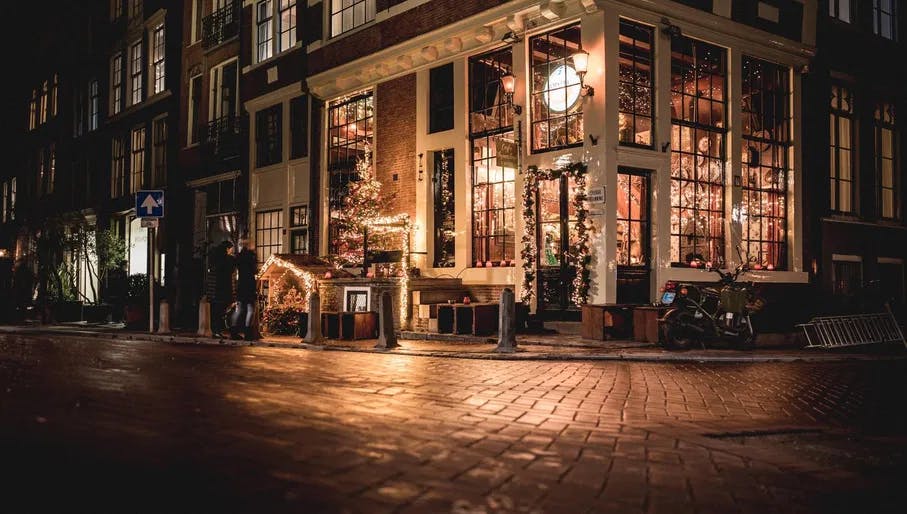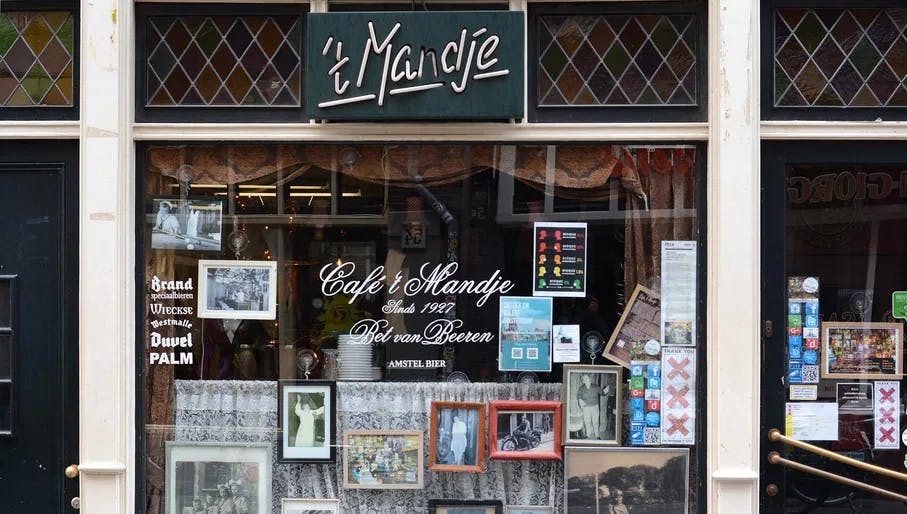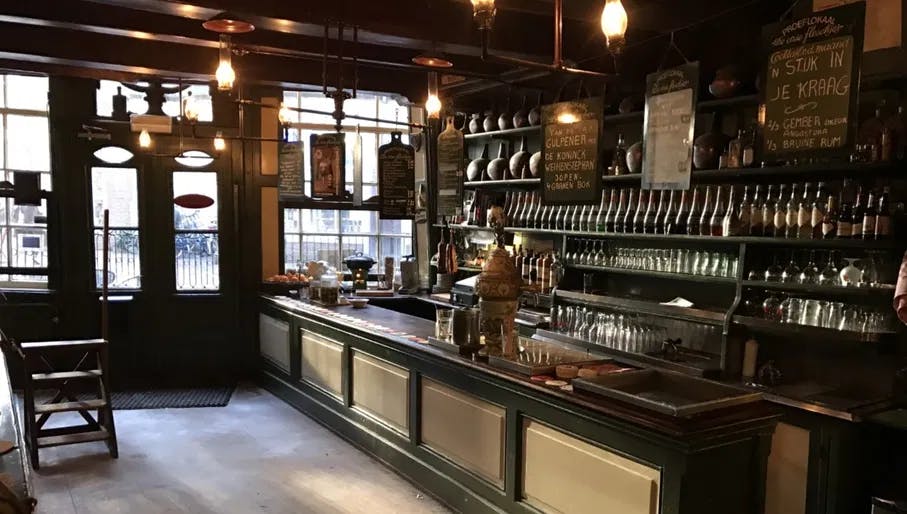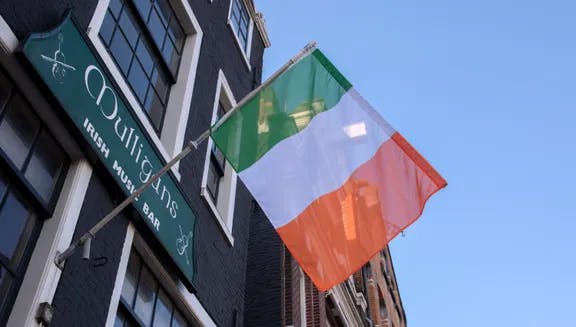
Wonky pubs and historic drinking holes in Amsterdam
Café de Schreierstoren

Situated on Geldersekade very close to Centraal Station, Café de Schreierstoren is located in a 15th-century defence tower that used to be part of the city wall. The name Schreierstoren (literally, ‘weeping tower’) is said to have been given because, during the era of the Dutch East India Company, this was the spot where women waved off their husbands before they went on long sea voyages. Pop by the café for lunch and beers with a beautiful view over the canals.
Café de Schreierstoren | Prins Hendrikkade 94-95
Cafe 't Papeneiland

Cafe 't Papeneiland (literally Pope Island) dates back to the Reformation Period when practising Catholic Mass publically was prohibited. The premises, built-in 1642, still conceals a tunnel in the basement that led to a secret Catholic church at Prinsengracht 7. That allowed for priests to be smuggled in and out from the Singel Canal. Today, the interiors have been restored to their 17th-century glory, with creaky floorboards, a central pot stove for heating and a Delft-tiled bar with old-timey fittings.
Cafe 't Papeneiland | Prinsengracht 2
Tip: To find out more about this period of history, don’t miss the Museum Ons’ Lieve Heer op Solder (Our Lord in the Attic Museum) - a uniquely preserved 17th-century house with an entire church concealed in the attic.
Café ‘t Mandje

In 1927, the pub at 63 Zeedijk was bought by Bet van Beeren, a working-class woman from the Jordaan who was openly lesbian. Bet named the premises ‘t Mandje ('the little basket') and transformed it into a safe space for lesbian and gay people of the time - despite the fact that back then, being homosexual was considered a criminal offence. This brown bar kitted out in eclectic memorabilia from decades gone by still maintains Bet’s ethos of fun and respect.
‘t Mandje | Zeedijk 63
Tip: Find out more about Amsterdam’s LGBTQ+ history with this themed walking route.
Café de Sluyswacht
Café de Sluyswacht is in the historic Sluyswachterhuisje (little lockhouse): an adorably wonky building dating on Jodenbreestraat dating back to 1695. Once upon a time, it was the lockmaster’s house. Later, it became a hardware shop, and for the last twenty years, it has been a café. As you’d expect, inside there is the original stone floor, wooden benches and panelling, a ceiling with beams and shuttered windows. This really is a taste of age-old Amsterdam.
Café de Sluyswacht | Jodenbreestraat 1
De Vergulden Eenhoorn

In the mid-17th-century, affluent Amsterdammers flocked to the newly-drained polder landscape in Amsterdam Oost to build their farmsteads and summer retreats. De Vergulden Eenhoorn is a historic monument and farm founded in 1702, which has since been converted into a charming pub and picnic garden. The name (The Gilded Unicorn) refers to the profession of the original owner, a surgeon. The unicorn was the symbol of physicians and apothecaries due to the medicinal powers which were attributed to the animal’s horn.
De Vergulden Eenhoorn | Ringdijk 58
De Drie Fleschjes

Bootz distiller established De Drie Fleschjes at the base of the Nieuwe Kerk in around 1650, making it the oldest tasting room in the city. A wall of casks showcases signature blends; the display of flagons (little bottles) with portraits of Amsterdam’s mayors is worth a peek. Slurp jenever from a tulip-shaped glass, or go for one of the 35 different liqueurs and brandies. What’s more, is that with an I amsterdam City Card, you can get a free shot of jenever.
De Drie Fleschjes | Gravenstraat 18
Check out this guide to the best spots to try jenever in Amsterdam.
Café In ‘t Aepjen

Situated in one of the city’s only remaining wooden buildings, In ‘t Aepje is officially Amsterdam’s oldest brown bar. Dating from 1475, the building’s annexe was made into a tavern in the 17th century. The story goes that, sailors paid their tab by surrendering the pet monkey they’d acquired on their travels to the Far East, hence the name (literally, in the monkeys). Located on the edge of the Red Light District, it boasts a lively atmosphere enhanced by the building’s character and range of reasonably priced beers and spirits to choose from. You’ll be treading on the same floorboards as vagabonds, sailors and merchants from centuries past!
Café In ‘t Aepjen | Zeedijk 1
Café de Ysbreeker
Café de Ysbreeker has always been used as a hospitality establishment in one form or another, and the building’s façade has remained unchanged since it was built in 1885. The inn owes its name to the icebreaker operated by the beer breweries of Amsterdam that kept the Amstel River open in cold weather. Initially frequented by sailors and locals, it later became the drinking hole for Amsterdam’s cultural and political elite. Today, this historical cafe is brimming with life, and customers will lose hours watching boats pass from the sunny riverside terrace.
De Ysbreeker | Weesperzijde 23
Café De Druif
This old-style Dutch pub has been serving liquor since 1631, gaining its reputation when Dutch naval hero Piet Hein professed that it was his favourite place to party. Inside, the old casks lining the walls behind the bar nod to the premise's former past as a distillery. Located close to the Entrepotdok, the pub was also used as an embarkation café where sailors would come to register themselves before boarding one of the Dutch East India Company ships.
Café De Druif | Rapenburgerplein 83
Proeflokaal De Ooievaar
This tiny corner tavern was originally a liquor tasting room for the Ooievaar Distillery and has been going strong since 1782. Prop up a stool and ask the bartender about the range of high-quality Jonge and Oude (young and old) jenevers you can sample along with a range of draft beers. Inside, the wooden floorboards, tiled walls and jar of boiled eggs on the bar give all the authentic vibes you could ask for. It's a well-seasoned drinking hole that has been frequented by fishermen and mariners for centuries.
Proeflokaal De Ooievaar | Sint Olofspoort 1
Related articles

Best spots to slurp jenever in Amsterdam

Best bitterballen in Amsterdam

Best tasting rooms in Amsterdam

Best rooftop bars in Amsterdam

LGBTQI+ bars and cafes in Amsterdam

Dutch foods to try in Amsterdam

Best Irish pubs in Amsterdam

Sun around the clock on these Amsterdam terraces

Best bars to watch live sports in Amsterdam
